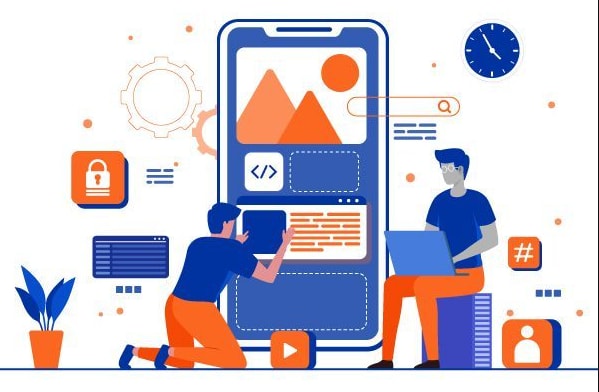Social Media App Development: Step-by-Step Guide

Key takeaways:
- With 6.05 billion users expected by 2028, social media apps are growing fast, creating opportunities for new entrants.
- Essential and advanced features for social media apps include profiles, feeds, media sharing, messaging, notifications, security, AR filters, and analytics.
- AI-driven personalization, social commerce, and AR/VR experiences are some of the emerging trends in social media applications.
- The cost to build a social media app ranges between $40,000 and $400,000 or more, depending on your project requirements.
- Partner with Appinventiv’s award-winning expertise to build a secure and scalable social media platform.
This is the net-savvy age, where you will hardly find a person who is not on social media platforms. Social media applications have completely changed the way we communicate. There are so many social networking titans like Meta, X, YouTube, Instagram, LinkedIn, TikTok; the list goes on and on. These social networking sites have the power to redefine the media, culture, education, politics, business and more.
Seeing the huge success and widespread popularity of these popular social media platforms, no wonder that you find yourself contemplating the process of creating your own social media app. But wait! Before diving into social media app development, you need to understand where the industry stands.
As per a report by Statista, the latest figure shows that there will be around 6.05 billion persons using social media accounts worldwide in 2028, with a projected increase of about 6 billion as compared to the past years.
While social media adoption continues to climb, user sentiment tells a different story. Gartner research reveals that approximately 50% of consumers have already or will limit or abandon their social media interactions by the end of 2025. Statista also supports this by uncovering the fact that the average social media usage per person daily decreased from 151 minutes in 2023 to 141 minutes in 2025.

These stats cite pressing concerns around misinformation, toxic environments, and the proliferation of bots.
However, this also creates an unprecedented opportunity for entrepreneurs. The market is primed for new social media platforms that prioritize authenticity, user experience, and AI Trism frameworks for genuine community building.
So, how to start a social media platform? Well, if you are planning for social media app development but are not sure how to get started, you have come to the right place.
This social media platform development guide familiarizes you with everything you need to know before you move on to creating your own social media platform. This guide will also help you understand whether developing a social platform is a viable business decision. Let’s jump right into the details.
Don’t Miss the Social Media Wave
Build an app that thrives in a world where over 6 billion users are expected by 2028.
Social Media App Development Market Stats: Is There Room for Your Social Media App?
The social media app market continues to grow, but with increasing concerns about platform authenticity and user engagement, there’s a need for understanding the market gap and growth opportunities. Contemplating the current market statistics will help you build a successful and sustainable app in this growing domain:
- As of October 2025, there are 6.04 billion internet users worldwide. Of this total, 5.66 billion, or 68.7% of the world’s population, are social media users.
- On average, six new users are added to the realm of social media platforms every second.
- The total number of active social media users in the US is 253 million in 2025. It simply means that 73% of Americans are found on social media.
- Social network usage is different for men and women worldwide on different platforms.
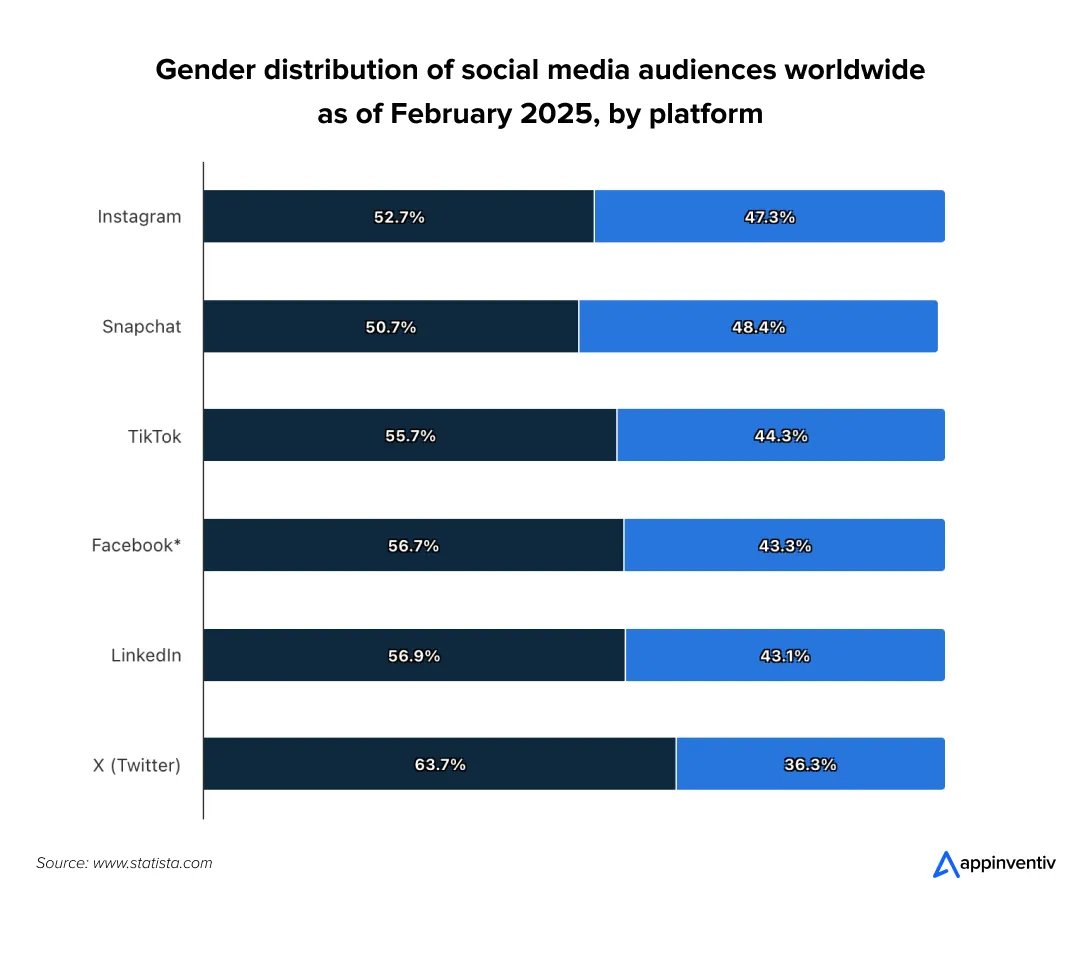
- Launched in 2016, TikTok became a huge hit among people of all genres in just a couple of years. Today, the TikTok application has more than 1.94 billion active users.
- Facebook is the most used social media platform, with 3.07 billion monthly active users. The below table outlines the total number of active social media users on different platforms.
| Social Media Applications | Active Users |
|---|---|
| 3.07 billion | |
| 3 billion | |
| YouTube | 2.54 billion |
| 2 billion | |
| TikTok | 1.94 billion |
| 1.4 billion | |
| Telegram | 1 billion |
| Messenger | 952 million |
| Snapchat | 900 million |
| 695 million | |
| 570 million | |
| X | 561 million |
These figures indicate that users will fall in love with your social applications wholeheartedly if it caters to their needs and interests.
The secret behind this ever-increasing use of social media platforms is their easy-to-use interface and an open forum that allows users to connect with one another from any corner of the world.
Essentially these features are the driving force behind the success of a social media app. But people have started to fall out of love with the stereotypical social applications as these sites have become a minefield of frustration for many creators, celebrities, politicians, and entrepreneurs alike.
Everything from trolling, data breaches, and distraction overload to constant algorithm updates contributes to the disenchantment of existing social media platforms. And users are looking for something better and newer options.
Thus, it’s high time to grab the opportunity and create a social media platform to expand your business’s digital presence.
What are Some Top Types of Social Media Platforms
Before you go ahead with your social media app development project, you must learn about what types of social media platforms are available and which one will best suit your business. This understanding will help you with further market research, and you can easily set your brand audience, simultaneously offering complete functionality to your users. Here are a few examples of different types of social media applications:

Social Networks
Leading Platforms: Facebook, LinkedIn
The primary objective of social network applications is to connect users worldwide. For instance, Facebook allows users to chat, voice/video call, upload short videos and share thoughts with almost any other users. LinkedIn, a business networking app, helps connect professionals and acts as a job portal for users.
Media Sharing Networks
Leading Platforms: YouTube, Instagram, Snapchat
These applications allow users to share any media content online. Users can share photos, videos, reels, and perform live incidents, and connect with other users. The thin line difference between social networks and media sharing networks has started to blur out with recent updates. For instance, Instagram and Snapchat carry almost the same set of features as Facebook. Another instance is YouTube, where users only upload and watch video content.
[Also Read: How to Build an App Like Threads? Process, Features, Cost ]
Discussion Forums
Leading Platforms: Quora, Reddit
Social applications like Quora and Reddit allow users to raise questions, comment, answer queries, and share valuable information. These platforms have gained massive popularity in the past few years since a major chunk of the digital population prefers looking for solutions online.
Content Sharing Networks
Leading Platforms: Pinterest, Flipboard
Content sharing platforms like Pinterest and Flipboard work like bookmarking apps that allow users to save and organize resources of various content (website, image, video, etc.) These platforms have exciting features that have transformed the way of content consumption, empowering users to discover, save, and share content with the world.
Consumer Review Networks
Leading Platforms: Yelp, TripAdvisor
Consumer review platforms like Yelp and TripAdvisor allow users to post and read reviews about businesses, travel destinations, products, etc. This helps them make informed decisions related to their day to day choices.
Interest-Based Networks
Leading Platforms: Goodreads, Houzz
These social networking platforms connect users based on shared interests or hobbies. For example, Goodreads is tailored for book enthusiasts, while Houzz focuses on home improvement and design.
Messaging Applications
Leading Platforms: WhatsApp, WeChat
Messaging apps like WhatsApp and WeChat focus on direct person-to-person communication. These apps enable users to send text messages, record voice messages, make video calls, and share images and documents.
Business Networks
Leading Platforms: Slack, Microsoft Teams
These platforms are designed to enhance organizational communication and collaboration initiatives. These platforms offer features like project management tools, chat rooms, and integration with other productivity apps.
Dating and Social Matching Networks
Leading Platforms: Tinder, Bumble
Dating and social matching apps like Tinder or Bumble are a huge hit these days. These apps connect individual, sharing similar profiles, interests, needs etc. for dating or social interactions.
Health & Wellness Networks
Leading Platforms: Strava, MyFitnessPal
Health, fitness and welllness related social networking applications are specifically designed for the communities of health and fitness enthusiasts. These platforms provide tools for tracking workouts, dietary needs, and sharing these achievements within a community.
Educational Networks
Leading Platforms: Edmodo, Academia.edu
As obvious from the name, these networks are designed to fulfill educational purposes. These platforms connect students, teachers, and researchers to share resources and collaborate on assignments.
Also Read: What Makes Social Networking Apps Successful
What Features Are Must to Make Your Social Media Application a Huge Hit in Users
Features significantly affect the social media app development cost. The more features you integrate into the application, the higher it will cost you. So, if you want to keep the cost within budget, you must know the features you require for your social media platform development.
Typically there are two different kinds of categories when it comes to social media app features- Must-Have and Advanced, and we are going to discuss both of these categories ahead.
Must Have Features for Social Media Applications
Features that are a must-have come under the MVP category. The MVP social media mobile platform features are described by functionalities of profiles, feeds, connections, and more.
UI/UX Design
Social media app design is an incredibly demanding feature since every user asks for a unique design pathway and easy-to-use interface. The trick is to settle on a design trend that most of your target audience would like. Here, you will need a knowledgeable social media platform development team to guide you through the entire process.

Profile
Profile creation is the first and foremost feature for all types of social media app development projects that allow users to add their information about name, age, gender, location, and photo, etc. The best way to create a user profile is to connect the app to an existing social media account through which the data can be retrieved. Another approach is the signup process, where you can fill in your user updates by entering your email ID and password, but this requires more effort, which nowadays users don’t usually like.
Feeds
This is a central space of any social networking platform. Feed is the place where users share content in the form of videos, audio, photos, etc. Thus, the social media app you develop must have a feature to share photos, videos, and status updates. You just need to upload, share the content, and specify the target audience you want to reach out to. Video-based social media apps like TikTok exhibit that sharing videos and similar content can help establish growth and presence easily.
Connections
The connection can be in the form of content, group, event, social network, SMS, address book, search, and recommendation. Content connection is totally dependent on the user. Users could be travelers, readers, or fashion enthusiasts. Groups are communities where people are connected to one another at a large scale. Sending invites for an event or selling event tickets in social groups is the best way to monetize through social media apps. It also helps in growing connections in the social media domain.
Signup
You should offer customers several registration alternatives to make it easy for them to come to your site and register themselves. For instance, you can incorporate options like email and password, phone number and password, or a guest user option. To make social networking apps more user-friendly and easy to understand, adding the ‘Forgot Password’ feature is important. For technology purposes, social media app developers can use Facebook or Google SDK, or Amazon SNS/ SES.
Chat
If you want to create a social media app like WhatsApp or you must add an impressive chat feature. Integrating the feature of sending messages, images, or videos is essential for any social networking app development project. The integration of group chats and channels allows users to chat with two or more users at the same time. You can use socket.io to create scalable chats.
Search Bar
Users need an easy-to-use search bar to find their friends or influencers to follow. For instance, it can be made possible to search for something by labels, user names, and locations.
Media Sharing
Such network applications permit users to share a wide range of media files (images, videos, GIFs, and so on). The most popular sites that support media-sharing features are Instagram, Snapchat, YouTube, Vimeo, and Imgur, among others.
Push Notifications
Push messages in apps like social media are useful for user engagement. The types of push messages that users can get include a new post from the community they are subscribed to, a new message, a response or remark to their post, and so much more.

Privacy & Security
Privacy and safety are indispensable features for social media app creation. Thus, without giving a second thought, you must add essential security measures like end-to-end encryption, multi factor authentication, and user-controlled privacy settings. These features will ensure a safe environment, protecting personal data and improving user experience.
Advanced Features for Social Media Web App Development
Now, as you know the must have features of a social media app, you should comprehend the other advanced features that make your social app popular. We often believe that the more features an application has, the higher user engagement it will receive.
However, it is not so. Integrating unnecessary features that don’t make sense to your business will just add to the complexity and cost of building a social media application. So, instead of piling up your application with so many stale sets of features, you should focus on just the advanced set of functionalities your application essentially requires.
Location-based content
This feature lets you know what your connections are doing or at what place they are. This is done by tagging your location to the post, or you can find connections who are in nearby locations and can socialize with them. The data is received through a location-based API which retrieves a particular location from your mobile network provider.
AR Filters
In order to make a social media app more unique, you can integrate certain filters into the videos and photos. For reference, Snapchat and Instagram have a bunch of AR filters that help attract users to the social media network to become a part of the trend. Not to forget that AR technology also offers a unique user experience.
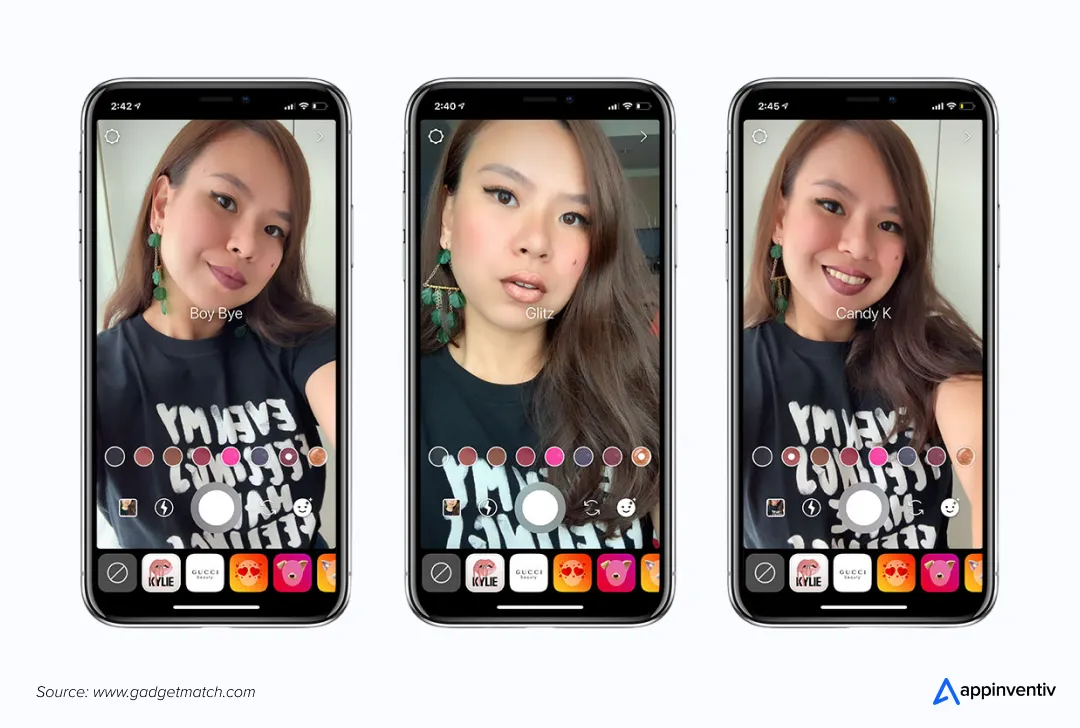
Editing
It’s a great idea to allow users to edit their photos and videos in the social media app. You can integrate options to crop or rotate the image, trim the video, create a collage, write text on it, etc.
Admin Panel
The Admin panel is typically the command center for the social application. With this centralized panel, you will have control over the entire system, features, and everything that happens within your social media app. You can also register new users, ban users in case of any violation and monitor the user behavior on the social network. Moreover, you can also go for analytics and advertising integrations, where you can advertise services and products and monitor the success of your application.
Apart from all these basic and advanced features, you can also add features that align with your niche and are unique from your competitors.
Also, check out:- 5 technologies and features that are taking social media platforms to the next evolution
Selecting the Best Monetization Strategy for Your Social Media App
Selecting the right business model is crucial for the success of your social media app. Monetization strategies like ads, freemium models, subscriptions, partnerships, and e-commerce integration each offer unique advantages and challenges.
The right choice depends on your app’s target audience, features, and long-term goals. Understanding the pros and cons of each model will help you make an informed decision that maximizes revenue and user engagement.
| Monetization Model | Pros | Cons | When to Use |
|---|---|---|---|
| Ads | Low barrier to entry, scalable, and flexible | Can disrupt user experience, reliance on traffic volume | If your app has a large user base and traffic |
| Freemium | Engages users with free content, potential for upsell | Users may not convert to premium, requires strong features | For apps offering both free and paid feature sets |
| Subscriptions | Predictable revenue, encourages loyal users | Can limit user base, may need constant content updates | For apps offering ongoing value like exclusive content |
| Partnerships | Low investment, potential for brand collaboration | Dependent on partners, potential loss of control | When collaborating with brands or influencers |
| E-commerce Integration | Direct revenue from product sales, smooth user experience | Requires significant inventory management | For apps that focus on product or service sales |
How Much Does It Cost to Build a Social Media App?
“How much does it cost to develop a social media app?” This is typically the most asked question right after “how to build a social media platform?”
Knowing an estimated cost of social media app development will help you make financial preparations. To determine the cost, all you need to do is to follow a simple formula.
Cost = (Hourly Rate of Developers) x (Total Development Hours)
For instance, a project with 4-6 months timeline and hourly rate ranging from $50 to $150 per hour will cost anywhere between $32,000 and $144,000.
On average, the cost to create a social media app ranges between $40,000 and $400,000, or more, depending on the complexity of your application.
Here is a table outlining the social media app development cost based on project complexity:
| App Complexity | Average Cost |
|---|---|
| Simple app with basic features | $40,000-$100,000 |
| Medium complex platform with moderate features | $100,000-$200,000 |
| Highly complex system with advanced features | $200,000-$400,000 or more |
The price range also differs according to the location and experience of your social media app development services provider. However, make sure to put quality before the cost and partner with a reputed app development company (such as Appinventiv) for all your Android or iOS social media app development project needs.
[Also Read: How much does it cost to build an app like WeChat]
What is the Timeline of Social Media App Development
Knowing how much time your cross-platform, iOS, or Android social media app development project will take and when you can expect to bring your app to the market is typically the first step to know how to start a social media platform. It will help you plan for a timely market launch, drive huge attention, and ensure the potential success of your app within a shorter span. So, let’s consider the development time of the backend part and get an estimated time range for each feature.
| Feature (MVP and Advanced) | Backend development time |
|---|---|
| Sign-in and Log-in | 50 – 54 hours |
| User Profile | 70 – 72 hours |
| Newsfeed | 60 – 62 hours |
| Search bar | 35 – 40 hours |
| Chat | 90 – 100 hours |
| Push notifications | 15 – 20 hours |
| Add post (media sharing) | 10 – 12 hours |
| Filters | 4 – 6 hours |
| Location based content | 10 – 15 hours |
| Editing | It depends on the editing options you provide |
| UI/UX design | Depends on your niche and development team |
Apart from these MVP and advanced features, there are other significant aspects you should take into consideration before moving to the custom social media app development stage.
| Features | Total Time (backend development) |
|---|---|
| Basic features (MVP) | 320 – 330 hours |
| Admin panel | 140 – 150 hours |
| DevOps | 40 – 50 hours |
| Quality assurance | 140 – 150 hours |
| Frameworks and libraries (tech stack) | 15 – 20 hours |
| Project management | 110 – 120 hours |
On average, it takes around 3-6 months to build an MVP version for Android or iOS social media app development. An advanced version or enterprise-grade social application requires 6 months to a year or more for full scale development.
How to Create a Social Media App: Team and Tech Stack
In order to build a social media app, you need a team of reliable professionals. Your development team must have:
- Project manager
- UI/UX designers
- iOS/Android developers
- Backend/frontend engineers
- QA specialists
Understanding the process of how to develop a social media app can be a little confusing without discovering what technology stacks required to develop the type of app you are targeting. Considering it, here are some of the most popular tools and technologies required for your custom social media app development.
| Development components | Android social media app development | iOS social media app development | Cross platform app development |
|---|---|---|---|
| Programming language | Kotlin, Java | Swift, Objective-C | Kotlin, Java, Swift, Objective-C |
| Notifications | Google Cloud Messaging | Apple Push Notifications | Google Cloud Messaging, Apple Push Notification |
| Database management | MongoDB, SQL, MySQL | Core Data, SQLite | MySQL, PostgreSQL, or MongoDB |
| IDE | Android Studio | Xcode | Xamarin |
| SDK | Android SDK | Cocoa Touch | Xamarin |
| Geolocation | Google Map API | MapKit | Google Maps API, Mapbox, Geolocation API |
| Analytics | Azure Stream Analytics, MixPanel | App Analytics, Firebase Analytics, Mixpanel, Flurry | Google Analytics, Firebase Analytics, Mixpanel |
| AR filters | ML Kit | ARCore | |
| Storage | Amazon S3, Azure Server | iCloud, Amazon S3, Google Cloud Storage | Amazon S3, Google Cloud Storage, Firebase Cloud Storage |
Also Read: 5 Technologies Taking Social Media Towards Its Next Evolution Set
Social Media App Development Process: A Step by Step Guide
The development of a social application is a complex journey that requires thorough planning and careful execution of the same. The journey encompasses a series of essential social media app development steps. Each step plays a crucial role in bringing your vision to life. Let’s discover how to make a social media app step by step:
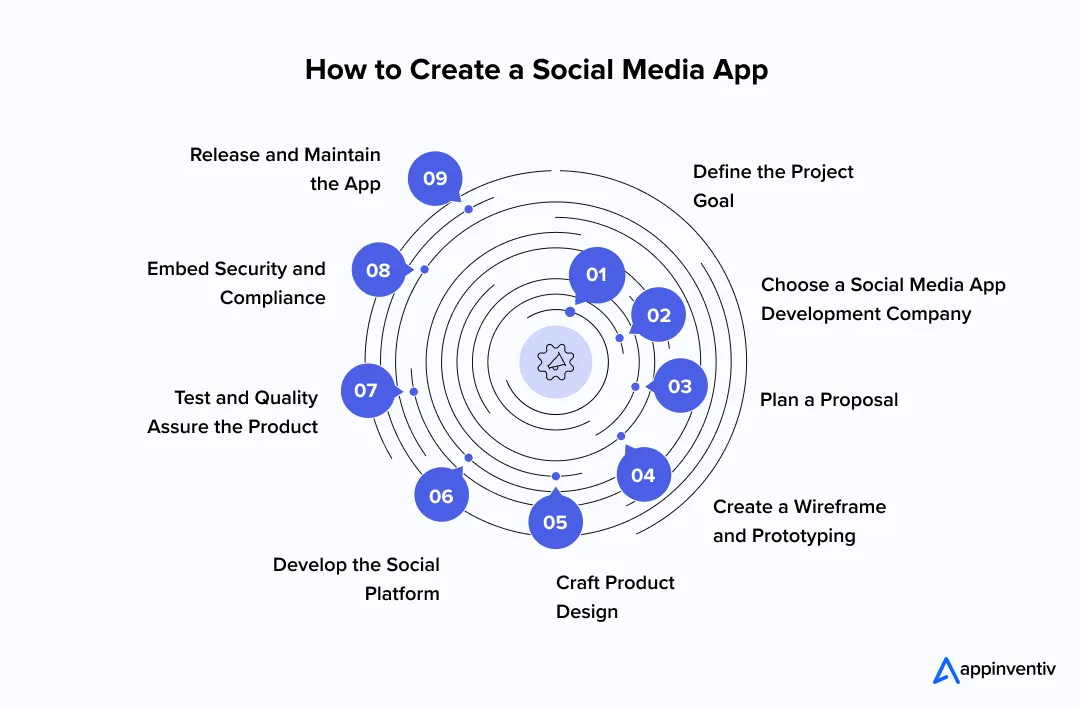
Define the Project Goal
The first and foremost step of social media app development starts with defining the purpose of your application, target audience, and value proposition. But how will you do it? Well, you need to conduct thorough market research, brainstorm ideas, and outline the core functionalities of your application. At this stage, you must identify key milestones and set realistic goals to ensure a smooth development process.
Choose a Social Media App Development Company
Now, you need to choose a knowledgeable and experienced social network app development company (like Appinventiv) with a proven track record of delivering next-gen social media applications and a portfolio of past work. It will help you gain an understanding of their work and know how they can be your perfect tech partner in your journey of social media app development.
Plan a Proposal
The app development company discusses your requirements and evaluates your projects to create a business proposal. This proposal serves as a preliminary roadmap of the social networking app development process, reflecting their understanding of your project and how the process will unfold. The proposal will also include the development timeline and technology stack they will use to create a social media platform.
Create a Wireframe and Prototyping
In order to bring your vision into reality that can best match your expectations for the application, the development company first creates a wireframe and prototype of the process. A competently designed wireframe is an assurance that the user can rapidly navigate and comprehend how the social media app will address their concerns. Also, it will help give you insights into the functionality of the forthcoming app without the need for actual software implementation.
Craft Product Design
The next step is to draw and plan the social media app design of all the screens and the essential features of the social media (network) application. At Appinventiv, we utilize the suggestions of Google and Apple to design the application. We assemble illustrations that are understandable and convenient to create a design that will set your app apart.
Develop the Social Platform
Once the contract is set, designers send the final draft to the social media app developers so that they can finally start creating your masterpiece. At this stage, developers build a robust frontend and backend infrastructure that powers your social media app. They develop a secure database to store users’ data and integrate cloud services to handle the app’s storage requirements. Furthermore, they integrate the UI design and other features into the application.
Test and Quality Assure the Product
Once the product is developed with all the features and functionalities, QA engineers test the working of your social media application. The quality specialists thoroughly check the bugs and malfunctions and pack them into bug reports. These reports serve as a roadmap for the developers, helping them address and resolve the identified issues to validate the app’s performance and user experience.
Embed Security and Compliance
Regulations like GDPR (European Union), CCPA (California), and equivalent laws worldwide impose strict requirements on how you collect, store, and handle user data. Social media apps must implement user consent forms, “right to be forgotten” capabilities, data encryption, and comprehensive privacy controls. Cutting corners on security inevitably leads to breaches, user lawsuits, and reputational damage.
Release and Maintain the App
After the final polish of your social media application, developers entrust the finalized version to you. Now, you can release your app to your target audience and update it periodically to keep it relevant and refined.
Social Media App Development Trends That Can Make It Stand Out From the Competitors
Social media app development landscape is evolving rapidly, with new platforms and technologies reshaping how users connect and communicate. Thus, to build a social media app that can stand out in the crowd, you must embrace the latest trends that resonate with modern users and technological advancements. Here are 6 key trends that can help a social app stand out:
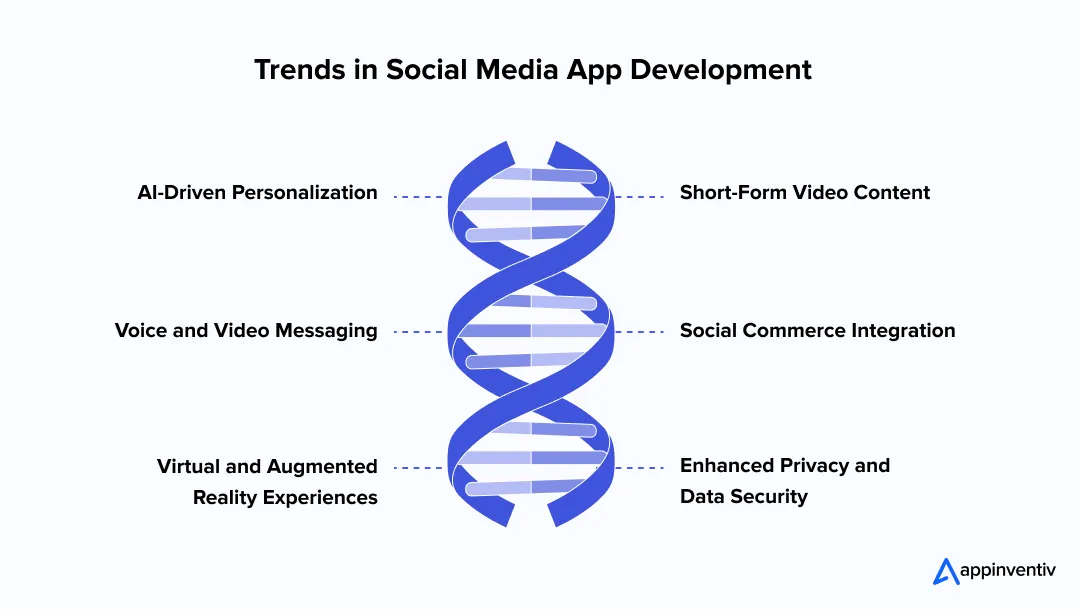
1. AI-Driven Personalization
Artificial Intelligence (AI) in social media applications is one of the most prevalent trends that is actively redefining user experiences and app growth. How? AI technologies help deliver highly personalized content.
For instance, social networking platforms like Meta’s Vibes and Google’s Gemini use AI to create tailored video feeds and interactive content. This results in enhanced user engagement and satisfaction.
2. Short-Form Video Content
Short-form videos in the form of Instagram reels or YouTube shorts have gained immense acceptance in the users. Thus, the apps that facilitate easy creation of videos and sharing of same can capture and retain user attention.
Users of all genres, particularly Gen Z and millennials, are going on this latest trend in social media applications.
3. Voice and Video Messaging
With the rise of remote communication, integrating voice and video messaging features have been the top trend of social media app development. This trend helps enhance user interaction and retention rate.
For instance, popular messaging apps like WhatsApp and WeChat have set the standard in this niche. These leading platforms incorporated similar functionalities after a few years of their launch and witnessed a huge improvement in user engagement rate.
4. Social Commerce Integration
E-commerce within social media applications is on the rise. Integrating shopping features, such as in-app purchases and product tagging, can provide users with a seamless shopping experience.
Apps like TikTok, Meta and Instagram have successfully incorporated these features, which resulted into both improved user engagement and revenue.
5. Virtual and Augmented Reality Experiences
Incorporating virtual and augmented reality (VR and AR) in social media apps can create unique and immersive experiences that elevate user interaction on social apps. Whether it’s trying on makeup virtually, visualizing furniture in a room before purchasing, or engaging in a virtual world for gaming and socializing, VR and AR trend can differentiate a social app by merging the digital and real worlds.
6. Enhanced Privacy and Data Security
With growing concerns over data privacy, ensuring robust security measures has been a non-negotiable trend of all time. Thus, you must embrace this trend and incorporate security features like end-to-end encryption, transparent data policies, and user-controlled privacy settings to build trust and attract privacy-conscious users.
Don’t Miss Out on the Social Media App Development Trends
Start Building Your App with Appinventiv Today
Appinventiv’s Case Studies in Social Media App Development
At Appinventiv, we focus on turning creative ideas into successful social media platforms. Here are a couple of examples from our portfolio:
Vyrb
The Challenge: The client wanted a voice-controlled social media app for users on the move, particularly with Bluetooth wearables, enabling them to interact with their feeds hands-free.
Our Solution: We built a voice-first social media app that integrates with major platforms and supports simple spoken commands. Users can post, reply, and browse using just their voice, ensuring smooth interaction and stable cloud performance.
The Impact:
- $1 million+ in funding secured
- 50,000+ downloads in the first release
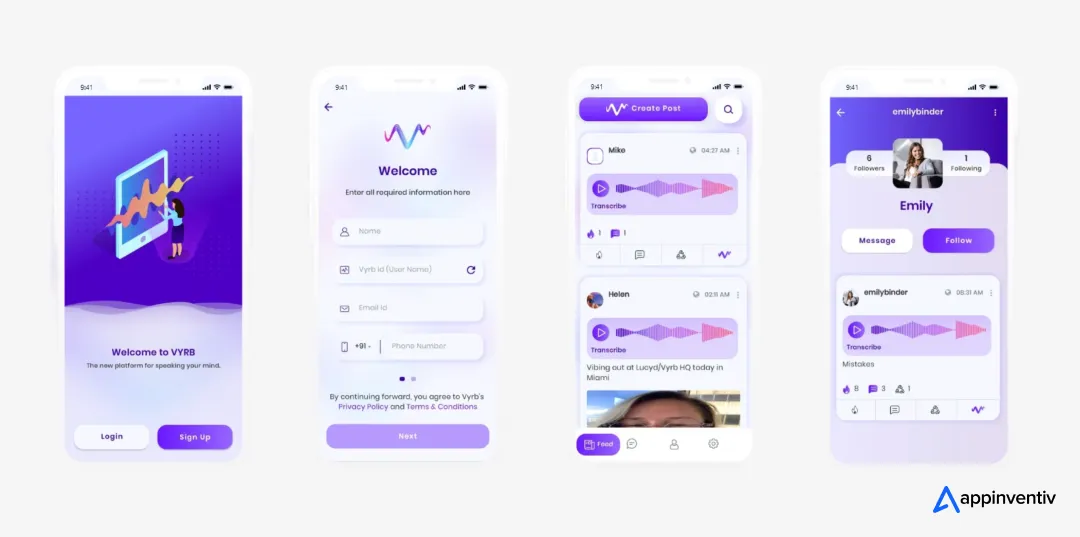
Avatus
The Challenge: The client sought to create an avatar-based platform with blockchain security, digital identities, and in-app currency.
Our Solution: We developed Avatus, a secure platform where users can design avatars, interact privately, and trade using Avat Coins. The platform leverages cloud and blockchain technology for secure, scalable performance.
The Impact:
- A highly secure, scalable ecosystem
- Strong features for long-term user engagement
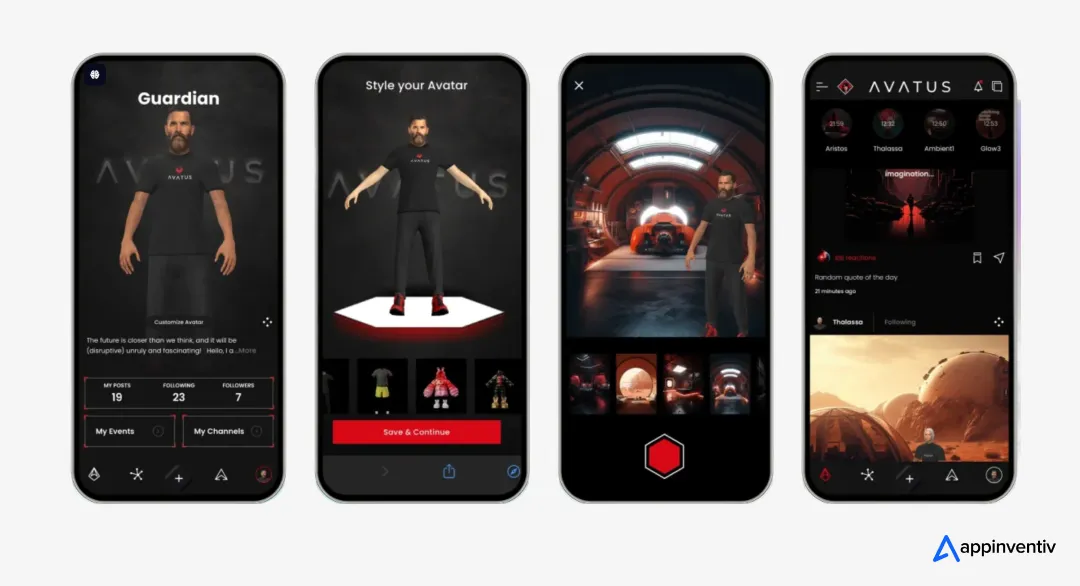
MOXY
The Challenge: The client aimed to create a platform connecting citizens, elected officials, and organizations, modernizing democratic engagement and managing large data from third-party sources.
Our Solution: We developed MOXY as a secure, scalable platform for civic participation, integrating audio chats, live streaming, and podcasts, while managing verified data for representatives.
The Impact:
- 10,000+ downloads within weeks
- Streamlined data delivery and faster responses
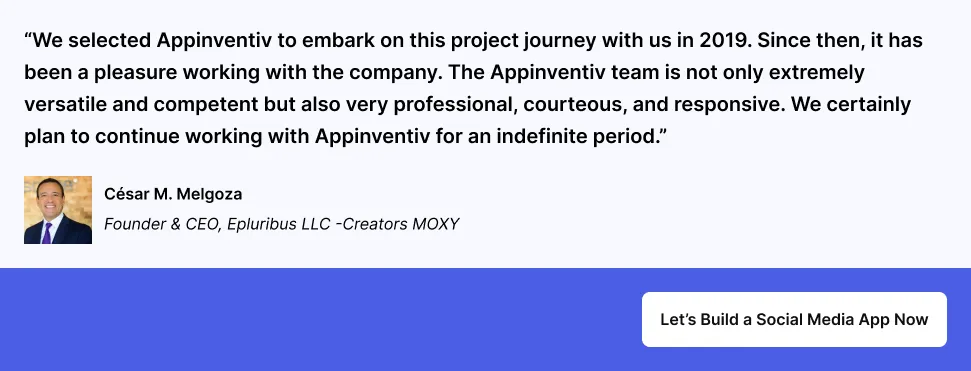
Appinventiv – Your Trusted Social Media App Development Partner
Embarking on the journey of social media application development is like venturing into a realm of infinite connections and endless possibilities like Facebook, Quora, etc. In today’s digital world, where online interactions have become an essential part of our day-to-day activities, comprehending the nuances and understanding how to build a social media app for your target audience carries prime importance.
To create a social media app, you must partner with a reputable social media app development company like Appinventiv. With over 10+ years of unrivaled expertise across all major mobile platforms, including Android and iOS, we can be your trusted tech partner to transform your visionary ideas into revolutionary realities.
Our special media development services range from custom social network and messaging apps to full-fledged app development. Our team of 1600+ tech experts has worked in the field of mobile app development and has helped clients across 35+industries with their social media apps. We have:
- Launched 150+ social media platforms
- Delivered 300+ solutions
- Transformed 500+ legacy systems
We are also proud of our:
- 100M+ app downloads globally
- 90% repeat clientele
- 95% client satisfaction rate
- Deloitte Fast 50 India award for two consecutive years (2023 & 2024)
Now, it’s time to take the leap. The world of social media app development awaits you. Connect with our team of social media app development professionals and begin the transformative journey to shape the future of digital interactions.
FAQs
Q. How long does it take to build a social media app?
A. Social media application development time majorly depends on the complexity of the app, the features and functionality of the app, and the experience of the app development team. On average the time it takes to build a social media app is:
- MVP development: 4 – 6 months
- Medium complex app: 6 – 9 months
- Advanced app: 9 – 12 months
- Enterprise grade app: 12 – 18+ months
Q. What makes a social media platform successful?
A. Some of the most popular tips that make your social media apps successful are:
- Put yourself in the audience’s shoes
- Pick a niche and cater to it completely
- Observe and follow your competitors
- Keep pace with the trends in social media app development
Q. What questions should I ask my social media app development company?
A. Here are a few questions you can ask your social media app development company for better engagement:
- How can we display the USP of my app?
- What designs can we use for the maximum user experience?
- How can we manage the complete project in the required time?
- What is the technical expertise of the team I must be aware of?
- What is the post-development support?
Q. How can I make money with social media apps?
A. There are various ways to generate revenue from a social media app. Common methods include advertising, in-app purchases, subscription services, and partnerships. Advertising is often the primary revenue source, where businesses pay to showcase their products to your users. In-app purchases can involve offering premium features or exclusive content.
A subscription model allows users to pay for enhanced access or special features. Additionally, forming partnerships with brands or influencers can generate income through collaborations or sponsored posts.
Q. How much does it cost to create a social media app?
A. The cost of developing a social media app can vary widely based on factors such as the desired features, complexity, and the location of the development team. Generally, creating a basic social media app might cost anywhere from $40,000 to over $40,000.
Here is a breakdown of social media app development cost based on project complexity:
- MVP development: $40,000 to $100,000
- Medium complex app: $100,000 to $200,000
- Advanced app: $200,000 to $400,000
- Enterprise grade app: $400,000 to $600,000
Q. How to make a social media app?
A. Here are the basic steps that can help businesses in understanding how to build a social media app that engages users effectively, provides a unique value proposition, and stands out in a competitive market:
- Define your concept and goals
- Conduct market research
- Identify your target audience
- Choose the features and functionalities
- Create wireframes and design the user interface
- Develop the app (frontend and backend)
- Add security and compliance features
- Test the app for bugs and usability
- Launch the app
- Gather user feedback and make improvements
Q. What’s the best tech stack for a social media app?
A. The best tech stack for social media app development are:
- Frontend: React Native, Flutter, React.js or Vue.js
- Backend: Node.js, Ruby on Rails
- Database: MongoDB, PostgreSQL
- Real-Time Communication: WebSockets or Socket.io
- Cloud Storage: Amazon S3or Google Cloud Storage
- Authentication: OAuth or JWT
- Push Notifications: Firebase Cloud Messaging or OneSignal
- AI & Machine Learning: TensorFlow or PyTorch

Prateek Saxena
DIRECTOR & CO-FOUNDER
link




